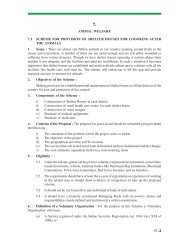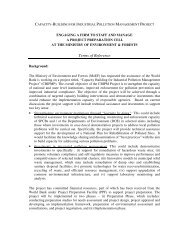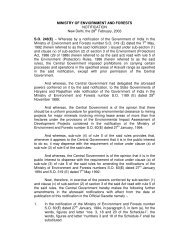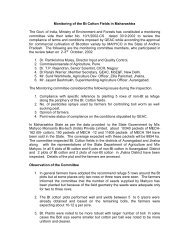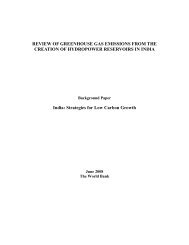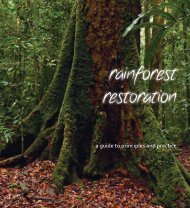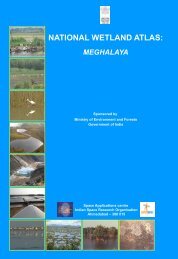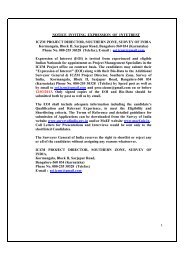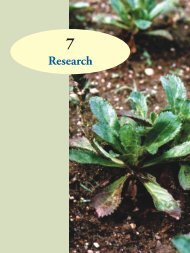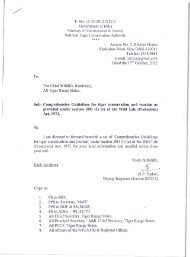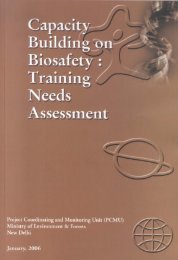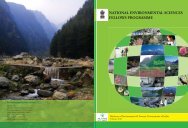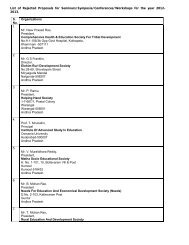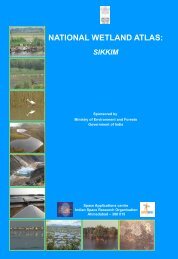Wetlands Atlas - Ministry of Environment and Forests
Wetlands Atlas - Ministry of Environment and Forests
Wetlands Atlas - Ministry of Environment and Forests
Create successful ePaper yourself
Turn your PDF publications into a flip-book with our unique Google optimized e-Paper software.
9.2 Keoladeo Ghana National Park (Ramsar Site)<br />
Name<br />
Location<br />
Area<br />
Wetl<strong>and</strong> Type<br />
Keoladeo Ghana National Park<br />
27°07'34” to 27°12'16” N Latitude <strong>and</strong><br />
77°29'28” to 77°33'40” E Longitude<br />
2912 ha<br />
Inl<strong>and</strong> <strong>Wetl<strong>and</strong>s</strong> : Man-made Waterlogged<br />
Climate Average annual temperature range from a maximum <strong>of</strong> 32.6 o C <strong>and</strong> a minimum <strong>of</strong> 15.6 o C.<br />
Keoladeo National Park comprises a freshwater swamp which is part <strong>of</strong> the Indo-gangetic Great<br />
Plains. Keoladeo Ghana is <strong>of</strong>ten known, is the most famous wetl<strong>and</strong> in India. It was designated as<br />
a Wetl<strong>and</strong> <strong>of</strong> International Importance under the Ramsar Convention in October 1981. It is situated<br />
in a shallow, natural depression at the western edge <strong>of</strong> the Gangetic plain. The environment is<br />
Description<br />
partly man-made with earthen dykes ( bunds) dividing the area in 10 to 15 units, each with a system<br />
<strong>of</strong> sluice gates to control water level. It support large number <strong>of</strong> avifauna but due to non-availability<br />
<strong>of</strong> water from Ajan Dam the number is diminishing every year.<br />
The surround area <strong>of</strong> bunds is predominated by angiosperms- terrestrial vegetation. There is<br />
Vegetation egress <strong>of</strong> prosopis sp. Salvadora oleoides, <strong>and</strong> Capparis aphylla <strong>and</strong> it is a major nuisance causing<br />
change in biodiversity <strong>of</strong> terrestrial vegetation.<br />
In all 332 species <strong>of</strong> birds have recorded in the park. Keoladeo is particularly famous for its<br />
wintering flock <strong>of</strong> Siberian white cranes (Grusleucogeramus). Some <strong>of</strong> the important avifauna<br />
Fauna<br />
includes Sarus cranes (Grus antigone), Pelecanus philippensis, P. crispus, Amaurornis<br />
phoenicurus, Anhinga melanogaster, E. garzetta, Charadrius alex<strong>and</strong>rinus, Limosa limosa, Tringa<br />
stagnatilis, T. glareola, Anas acuta, A. crrcca, A. strepera Fulica atra, G. grus, etc.<br />
Turbidity Low-moderate<br />
Post monsoon data (2006) Pre monsoon data (2007) Indices image<br />
Post monsoon data (2006)<br />
Plate 6: Keoladeo Ghana National Park<br />
170



